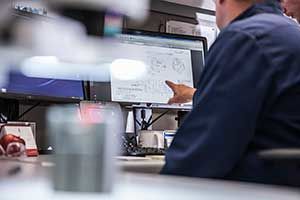We guarantee your manufactured component features will match your design print requirements to a T – said no one ever – at least before taking a close look at manufacturability.
The accuracy of product design prints keep customer-supplier relationships in harmony. It allows suppliers to manufacturer components to the print’s specifications and reduces future interruptions and requests for waivers. It also sets clear, upfront expectations between suppliers and customers.
Design markups, or redlining your prints, indicate  recommended tweaks to a profile’s dimensions so that the component can be accurately manufactured. Discussing design markups with your supplier, will typically lead to greater clarification on important features and complete understanding of component manufacturability.
recommended tweaks to a profile’s dimensions so that the component can be accurately manufactured. Discussing design markups with your supplier, will typically lead to greater clarification on important features and complete understanding of component manufacturability.
Why did you redline my prints?
Our team may redline product prints to draw a customer’s attention to tolerances and/or design changes that are necessary and mostly driven by the manufacturing processes used to make them. Redlines allow us to set tolerances accordingly, by focusing on critical features and not over inspecting noncritical areas.
Redlining starts the negotiations of acceptable feature tolerances and areas where we may need to consider adding material to an extrusion. We would then remove it in secondary operations to achieve tolerance requirements. Ideally, we try to provide this information during the quote stage. That way expectations are clear from the beginning—especially when recommended revisions to the print affects the costs.
Why do you redline when my other supplier has no exceptions?
Don’t take offense when we redline or want to make exceptions to your prints.
If you are sourcing components from other suppliers, we will ask you to provide samples to Alexandria Industries. The samples help us to understand what you are receiving and to quickly identify the manufacturing processes used to make your components in their current state. This allows us to adjust plans and assure you that the components we are preparing to make will be exactly what you are expecting.
Your samples also provide us opportunity to discuss inspection methods with you. We do this to understand if the inspection methods and specifications we anticipate using are different than what your current suppliers provide. We want to assure you consistent, high quality components that meet agreed-upon specifications. We inspect all dimensions and will not knowingly send product that is out of tolerance. You can always count on us to do the right thing.
You already quoted my component, why are you redlining my print now?
More than likely, when we initially quoted your component, we evaluated it based on the print you provided, without an in-depth analysis of its manufacturability. Many times, we provide an initial cost estimate in order for you to understand our pricing competitiveness and to determine if we are in the right ballpark.
As you can imagine, a deep-dive, full analysis of component manufacturing takes time and resources. Your component may be dynamic enough to require feedback from our manufacturing experts and this feedback could be the drivers of our redlining your design print. Our experts could be requesting print changes because these adjustments may save you money, shorten manufacturing time, or improve component quality. (See this white paper for more detailed information: Five Tips for Aluminum Extrusion Dimensioning and Tolerancing.)
No one wants to receive a quote and submit the purchase order, only to be told the part is not manufacturable. To avoid the last-minute shuffle, clear and open communication of profile design specifications is a must-have, and doing that sooner than later can provide enormous value.
What’s next?
At Alexandria Industries, we rely on our experts ingenuity and creativity to look for ways to do things better every time, even if we have done something the same way a hundred times. If we suggest making changes to your prints, it is intended to be for good reason. We want you to be completely satisfied with the result.
